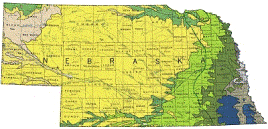US Geological Survey
Document Type
Article
Date of this Version
2009
Citation
Climatic Change (2009) 93:243–267 DOI 10.1007/s10584-008-9543-5
Abstract
The Prairie Pothole Region (PPR) is unique to North America. Its millions of wetlands and abundant ecosystem goods and services are highly sensitive to wide variations of temperature and precipitation in time and space characteristic of a strongly continental climate. Precipitation and temperature gradients across the PPR are orthogonal to each other. Precipitation nearly triples from west to east from approximately 300 mm/year to 900 mm/year, while mean annual temperature ranges from approximately 1◦C in the north to nearly 10◦C in the south. Twentieth-century weather records for 18 PPR weather stations representing 6 ecoregions revealed several trends. The climate generally has been getting warmer and wetter and the diurnal temperature range has decreased. Minimum daily temperatures warmed by 1.0◦C, while maximum daily temperatures cooled by 0.15◦C. Minimum temperature warmed more in winter than in summer, while maximum temperature cooled in summer and warmed in winter. Average annual precipitation increased by 49 mm or 9%. Palmer Drought Severity Index (PDSI) trends reflected increasing moisture availability for most weather stations; however, several stations in the western Canadian Prairies recorded effectively drier conditions. The east-west moisture gradient steepened during the twentieth century with stations in the west becoming drier and stations in the east becoming wetter. If the moisture gradient continues to steepen, the area of productive wetland ecosystems will shrink. Consequences for wetlands would be especially severe if the future climate does not provide supplemental moisture to offset higher evaporative demand.
Included in
Geology Commons, Oceanography and Atmospheric Sciences and Meteorology Commons, Other Earth Sciences Commons, Other Environmental Sciences Commons


Comments
U.S. government works are not subject to copyright.